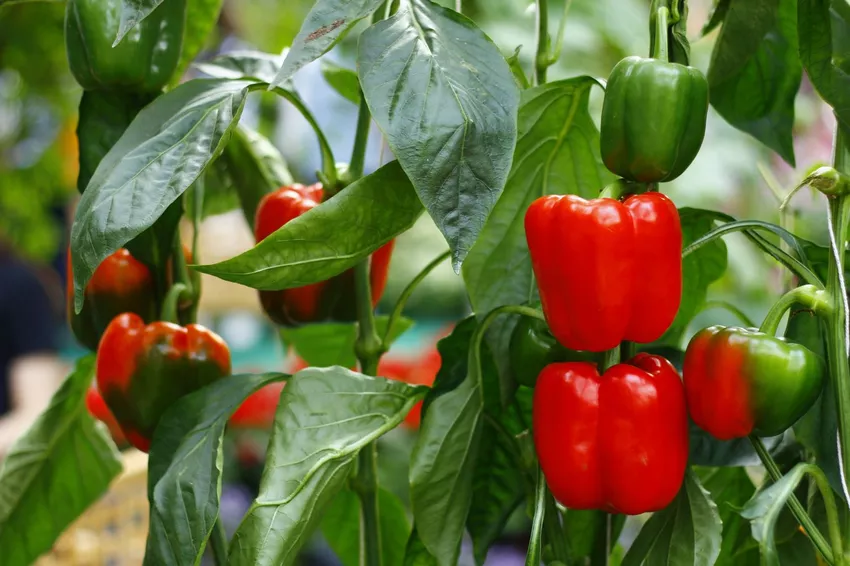The pepper harvest can be plentiful, but it can also take place within a very short time. Here's how to store peppers after harvest.

The paprika (Capsicum) is a real vitamin miracle. It contains more vitamin C than lemons, for example, and has other he althy ingredients such as carotenoids and capsaicin to offer. With increasing storage time, however, the colorful pod loses some of its he althy potential. We will tell you how to store your peppers correctly, what processing options there are and what you should consider when harvesting the peppers.
Harvest peppers
The pepper is a heat-loving vegetable that originated in tropical regions. The cultivation and harvest time in the moderate Central European climate is therefore limited to the summer months. Planted at the end of May, the peppers can be harvested between the end of August and well into October. The relatively long harvest period results from the fact that there is no such thing as the perfect time to harvest. Depending on your preference, you can harvest the peppers when they are green or wait until they are sun-ripened red.

Note: As already indicated, the different colors of the peppers can be traced back to the degree of ripeness. From green (tart, bitter taste; little sugar), to yellow (sweet and mild), to red and ripe peppers (a lot of sugar, vitamin C, carotenoids and capsaicin). Everyone can choose the harvest time according to their own taste.
Do not store peppers in the refrigerator
The peppers originally come from warmer regions of the world. This is also reflected in the storage requirements. Unlike other vegetables, you should not store the peppers in the refrigerator, otherwise they will wrinkle quickly and lose many of their he althy nutrients. The peppers are best stored in a dark cellar room at 8 to 10°C. Alternatively, you can store your peppers in an unheated storage room. To do this, simply cover the peppers with a towel or similar.

Tip: The best conditions for storage are already determined during the harvest. Be sure to harvest your peppers with a clean cut at the thinnest point above the pod. The fewer injuries the pepper has, the longer it will keep!
Storing and storing peppers
Freeze peppers
In contrast to storing them in the refrigerator, freezing peppers is a good alternative to preserve the peppers over the long term. To do this, wash and cut your peppers first. The paprika blanching - as with many other types of vegetables - can be omitted. Simply portion your peppers the size you want and place them in a freezer bag.

Note: The cell structure of the peppers is destroyed when they are frozen, so they lose their crunchy texture. The frozen diced peppers are still very good for cooking. Simply put the frozen pepper pieces on a pizza or in a soup. It saves time and tastes just as good!
Pinse the peppers
Pickled peppers are excellent for pickling in a mixture of oil, vinegar and spices. Depending on your preference, you can blanch or fry the peppers beforehand.
Important: After frying or blanching, allow the peppers to cool thoroughly before placing the prepared pods in a sealable container. The marinade of oil and/or vinegar can be seasoned to taste. The range goes from classic (only oil/vinegar) to seasoning with s alt and pepper to sophisticated seasoning mixtures with garlic, rosemary and other spices. Finally, put your prepared peppers in a closable container, fill this up with the marinade until everything is covered and then close it. The peppers can be stored in a dark, cool place for at least a year.
Canning/boiling peppers
Peppers (like almost any other vegetable) can be boiled down well. Before you boil the peppers, you should wash the pods, remove the seeds and cut them into cubes. Place the prepared cubes in a mason jar. The brew can be designed as you wish. Traditionally, a preserving brew made of water, (white wine) vinegar, s alt and some sugar is used. Heat it up and pour it over the diced peppers while it is still hot. At the top of theThere should still be about 1 cm of space left up to the lid. After sealing, the jars must be boiled in a boiling water bath for at least 30 minutes, and that's it!

Tip: Cook the peppers together with garlic and onions. These fine-spicy onions and vegetables give the paprika a fine taste note and perfectly round off the aroma of the brew.
Dry peppers
Another way to preserve peppers is to dry or dehydrate them. To do this, cut your peppers into flat strips and spread them out generously on a baking tray lined with baking paper. Place the baking tray in the oven at a constant 50 to 60°C on the medium setting for at least 6 to 8 hours. Patience is the key ingredient here: Depending on how thick the flesh of the pepper is, the perfect drying time may vary.

Tip: Thin-fleshed peppers, such as chili, can also be air-dried! To do this, simply thread the individual pods at the base of the stem and hang them in a dry place. If you have a chimney or stove, you can speed up the drying process by hanging the pods over the chimney. Keep an eye on the humidity when drying peppers: too much humidity can lead to premature spoilage of the pods.
You can find more information about peppers in our special article. There you will learn everything you need to know about vegetables - from cultivation and care to harvest.